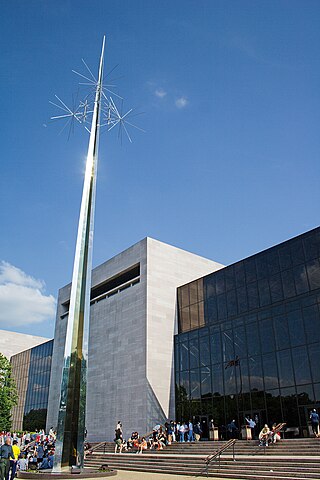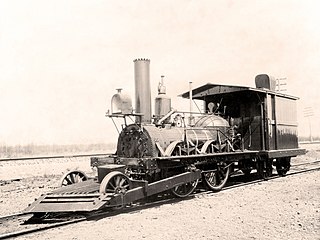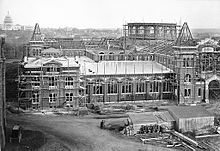
The Smithsonian Institution, or simply the Smithsonian, is a group of museums, education and research centers, the largest such complex in the world, created by the U.S. government "for the increase and diffusion of knowledge." Founded on August 10, 1846, it operates as a trust instrumentality and is not formally a part of any of the three branches of the federal government. The institution is named after its founding donor, British scientist James Smithson. It was originally organized as the United States National Museum, but that name ceased to exist administratively in 1967.

The Centennial International Exhibition, officially the International Exhibition of Arts, Manufactures, and Products of the Soil and Mine, was held in Philadelphia from May 10 to November 10, 1876. It was the first official world's fair to be held in the United States, and coincided with the centennial anniversary of the Declaration of Independence's adoption in Philadelphia on July 4, 1776.

The National Air and Space Museum (NASM) of the Smithsonian Institution, is a museum in Washington, D.C., in the United States dedicated to human flight and space exploration.

The Arthur M. Sackler Gallery is an art museum of the Smithsonian Institution in Washington, D.C., focusing on Asian art. The Sackler Gallery and the Freer Gallery of Art together form the National Museum of Asian Art in the United States. The Freer and Sackler galleries house the largest Asian art research library in the country.

The National Portrait Gallery (NPG) is a historic art museum between 7th, 9th, F, and G Streets NW in Washington, D.C., in the United States. Founded in 1962 and opened to the public in 1968, it is part of the Smithsonian Institution. Its collections focus on images of famous Americans. Along with the Smithsonian American Art Museum, the museum is housed in the historic Old Patent Office Building.

The Anacostia Community Museum is a community museum in the Anacostia neighborhood of Washington, D.C., in the United States. It is one of twenty museums under the umbrella of the Smithsonian Institution and was the first federally funded community museum in the United States. The museum, founded in 1967, was created with the intention to bring aspects of the Smithsonian museums, located on the National Mall, to the Anacostia neighborhood, with the hope that community members from the neighborhood would visit the main Smithsonian museums. It became federally funded in 1970 and focuses on the community in and around Anacostia in its exhibitions. This museum also houses a library.

The Brooklyn Museum is an art museum located in the New York City borough of Brooklyn. At 560,000 square feet (52,000 m2), the museum is New York City's second largest and contains an art collection with around 500,000 objects. Located near the Prospect Heights, Crown Heights, Flatbush, and Park Slope neighborhoods of Brooklyn, the museum's Beaux-Arts building was designed by McKim, Mead & White.

The National Museum of American History: Kenneth E. Behring Center collects, preserves, and displays the heritage of the United States in the areas of social, political, cultural, scientific, and military history. Among the items on display is the original Star-Spangled Banner. The museum is part of the Smithsonian Institution and located on the National Mall at 14th Street and Constitution Avenue NW in Washington, D.C.

The National Museum of Natural History (NMNH) is a natural history museum administered by the Smithsonian Institution, located on the National Mall in Washington, D.C., United States. It has free admission and is open 364 days a year. with 4.4 million visitors in 2023, it was the most-visited museum in the United States.

Cooper Hewitt, Smithsonian Design Museum is a design museum housed within the Andrew Carnegie Mansion in Manhattan, New York City, along the Upper East Side's Museum Mile. It is one of 19 museums that operate within the Smithsonian Institution and is one of three Smithsonian facilities located in New York City, the other two being the National Museum of the American Indian's George Gustav Heye Center in Bowling Green and the Archives of American Art New York Research Center in the Flatiron District. Unlike other Smithsonian museums, Cooper Hewitt charges an admissions fee. It is the only museum in the United States devoted to historical and contemporary design. Its collections and exhibitions explore design aesthetic and creativity from throughout the United States' history.

John Bull is a historic British-built railroad steam locomotive that operated in the United States. It was operated for the first time on September 15, 1831, and became the oldest operable steam locomotive in the world when the Smithsonian Institution ran it under its own steam in 1981. Built by Robert Stephenson and Company, it was initially purchased by and operated for the Camden and Amboy Railroad, the first railroad in New Jersey, which gave it the number 1 and its first name, "Stevens". The C&A used it heavily from 1833 until 1866, when it was removed from active service and placed in storage.

The Smithsonian American Art Museum is a museum in Washington, D.C., part of the Smithsonian Institution. Together with its branch museum, the Renwick Gallery, SAAM holds one of the world's largest and most inclusive collections of art, from the colonial period to the present, made in the United States. More than 7,000 artists are represented in the museum's collection. Most exhibitions are held in the museum's main building, the Old Patent Office Building, while craft-focused exhibitions are shown in the Renwick Gallery.

Sanford Robinson Gifford was an American landscape painter and a leading member of the second generation of Hudson River School artists. A highly-regarded practitioner of Luminism, his work was noted for its emphasis on light and soft atmospheric effects.

The National Museum of African Art is the Smithsonian Institution's African art museum, located on the National Mall of the United States capital. Its collections include 9,000 works of traditional and contemporary African art from both Sub-Saharan and North Africa, 300,000 photographs, and 50,000 library volumes. It was the first institution dedicated to African art in the United States and remains the largest collection. The Washington Post called the museum a mainstay in the international art world and the main venue for contemporary African art in the United States.

The Renwick Gallery is a branch of the Smithsonian American Art Museum located in Washington, D.C. that displays American craft and decorative arts from the 19th to 21st century. The gallery is housed in a National Historic Landmark building that was opened in 1859 on Pennsylvania Avenue and originally housed the Corcoran Gallery of Art. When it was built in 1859, it was called "the American Louvre", and is now named for its architect James Renwick, Jr.
The Old Patent Office Building is a historic building in Washington, D.C. that covers an entire city block between F and G Streets and 7th and 9th Streets NW in the Penn Quarter section of Chinatown. Serving as an art gallery for the Smithsonian Institution since the 1960s, it first served as one of the earliest Patent Office buildings.

The Senator John Heinz History Center, an affiliate of the Smithsonian Institution, is the largest history museum in the Commonwealth of Pennsylvania, United States. Named after U.S. Senator H. John Heinz III (1938–1991) from Pennsylvania, it is located in the Strip District of Pittsburgh.

Memorial Hall is a Beaux-Arts style building which is located in the Centennial District of West Fairmount Park, Philadelphia, Pennsylvania. Built as the art gallery for the 1876 Centennial Exposition, it is the only major structure from that exhibition to survive. It subsequently housed the Pennsylvania Museum of Industrial Art.

The Museum of Us is a museum of anthropology located in Balboa Park, San Diego, California, and is housed in the historic landmark buildings of the California Quadrangle.



























